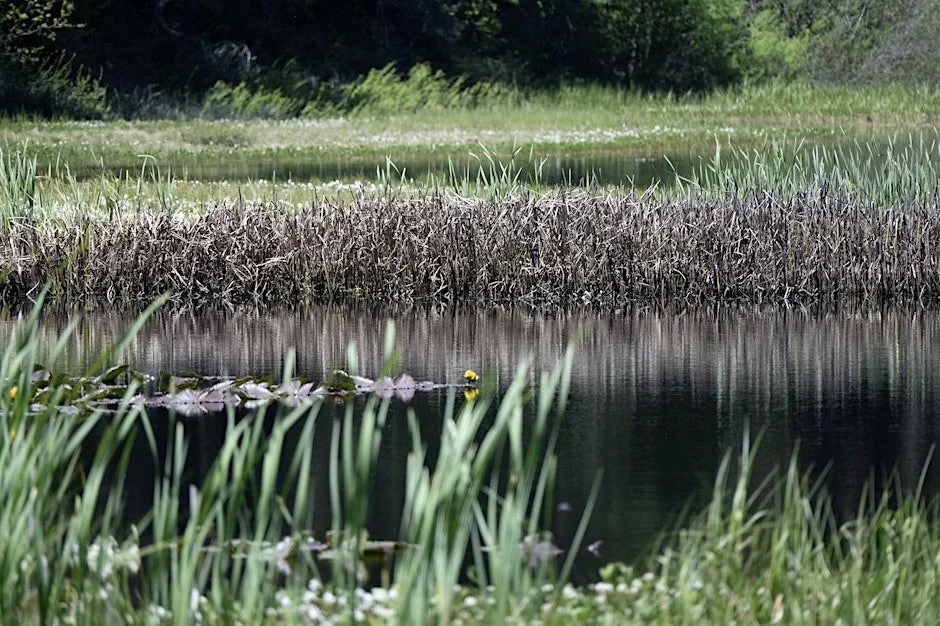Agate Desert
⟵ previous next ⟶
Acreage: 872
A Unique Remnant Landscape
The Agate Desert is, frankly, a lumpy landscape consisting of mini-round hills, mounded prairie, covered in grasses and flowers interspersed with dips and vernal pools. The pools sparkle with water during the wet season and are dry the rest of the year. The patterned ground of the Agate Desert is not a desert but was named by early settlers because of the absence of trees and the abundance of river-rounded agates. The Agate-Winlo soil, high in clay and with a hard pan, is not hospitable to deep rooting trees and shrubs.
This unique landscape located around White City, Central Point, and Eagle Point in Jackson County, Oregon was once more than 32,000 acres before EuroAmerican settlement. Now less than 20 percent of it remains. Where did it go? Flat valley-floor land without trees and shrubs was a convenient place for human development as the population of the Rogue Valley grew—farming, housing, and during World War II, Camp White, a sprawling military campus. Today much of the former Agate Desert is a mix of orchards, subdivisions, five-acre rural residential lots, towns, and industry.
The remnant Agate Desert landform is a place of beauty with big views of the Table Rocks and the mountains that frame the valley, drying pools with rings of colorful annual flowers, and Western Meadowlark song. It is beautiful with cars zipping by on highways and roads, airplanes taking off from the nearby Rogue Valley International Medford Airport, and the silhouette of big industrial buildings with smokestacks. It is also the home of federally-listed endangered and threatened species and many other rare plants. This disappearing landscape is part of our Agate Desert-Middle Rogue Focus Area where we focus our energy on conserving more land. Below is an example of the conservation easements we hold and preserves we own in the Agate Desert.
Properties
Driving on HWY 62 north of Eagle Point you may note an old cabin to the east framed by Mt. McLoughlin in the distance. This is the historical Wood House which is owned and managed by the Woodhouse Preservation Group. Surrounding the 19th century house is a 38-acre conserved property that includes a small irrigated agricultural area, and also a vernal pool-mounded prairie habitat. Adjacent to it, to the east, is another conserved private property (132 acres) that serves as a wetland mitigation bank.
Both properties support federally-listed threatened vernal pool fairy shrimp and the diminutive but lovely large-flowered woolly meadowfoam. Management includes controlled seasonal grazing to reduce nonnative annual grass cover. If the nonnative grasses, upland and pool grass species, are not controlled by either grazing or prescribed fire, the endangered and threatened species disappear.
The conservation easements held by Southern Oregon Land Conservancy protect the vernal pool-mounded prairie landscape, prohibiting the construction of new buildings and the destruction of this one-of-a-kind landscape. The seasonal grazing supports working lands while also maintaining a home for very rare and precious species—an invertebrate that swims on its back and a little white posey, both dependent on vernal pools in the Agate Desert.
The Southern Oregon Land Conservancy also owns properties featuring other vernal pool landscapes. The Rogue River Preserve, located along the Rogue River, contains nearly 40 acres of well-intact vernal pool habitat. The remainder of the 352-acre property features oak woodlands and floodplain forest. A population of large-flowered woolly meadowfoam has been observed on this property. The U.S. Fish and Wildlife Service declared the plant to be endangered under the Endangered Species Act in 2002.
In February 2022, The Nature Conservancy transferred three of their protected properties to the stewardship of Southern Oregon Land Conservancy. All of these properties provide critical vernal pool habitat. These three properties, Whetstone Savanna, Rogue Plains Preserve, and Agate Desert are located between Interstate 5 and Highway 62. Whetstone Savanna and a majority of Agate Desert will be under ownership of SOLC, and like the property around Woodhouse, SOLC will hold the conservation easement on the Rogue Plains Preserve. Threatened and endangered species such as the vernal pool fairy shrimp, Cook’s lomatium, and large-flowered woolly meadowfoam may be found on-site.
Federally listed endangered large-flowered woolly meadowfoam.
Federally listed endangered vernal pool fairy shrimp
Landowner and conservation easement donor Jud Parsons
Eagle’s eye view of the vernal pool meadow habitat.
Click to see larger
Wildflower bloom in the spring.
SOLC staff and lands committee members walk the property with the landowner for the annual conservation easement monitoring visit.
“We love the work that you guys do in saving the environment and the wonders in Southern Oregon. The easement that Southern Oregon Land Conservancy has on the lands near to and surrounding the Wood House structure helps the Woodhouse Preservation Group even more with our ultimate goal to preserve the Wood House proper and the existing environment that surrounds it. Thank you!!”










If you ever peer into a half-rotted log you might be so lucky to find a slippery pair of eyes staring back at you. If you’re extremely lucky those eyes could belong to a Pacific giant salamander (Dicamptodon tenebrosus). Usually seen wriggling through woody debris or eating a mildly toxic banana slug, these marbled beauties are found throughout western Oregon.